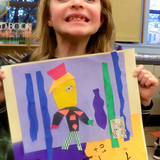Romare Bearden American 1912-1988

To celebrate Black History Month I chose the artist Romare Bearden, the most influential African American artist of the 20th century. His paintings, collages, and prints often reflected a particular part of the Black culture that I personally love: Jazz.
The only child of Richard and Bessie Johnson Bearden, he was born in 1912 in Charlotte, North Carolina and raised in New York City. His father worked as a sanitation inspector, and his mother became the New York editor of The Chicago Defender newspaper and the first President of the Negro Women's Democratic Association. The 1920s was a rich period of cultural flowering in the African American community known as the Harlem Renaissance. It was important to him to give a voice to the African American community and he made his memories of life in Harlem the basis of his art. He became deeply immersed in jazz and the Blues as an adolescent and his collages and paintings were often a tribute to the great Jazz artists that he saw in the clubs in his Harlem neighborhood. In 1950, Bearden went to Paris and study philosophy at the Sorbonne on the G.I. Bill. In Paris, he met painter Georges Braque, sculptor Constantin Brancusi, and a number of French and American artists and writers. He visited museums and galleries while traveling to Nice, Florence, Rome, and Venice. When he returned he set out to become a full-time professional artist, achieving international status by the 1960s. In addition to pursuing his art, He also continued his work as a social worker in New York for decades. Bearden wrote his first book, “The Painter's Mind” in 1969 and coauthored “Six Black Masters in American Art”. His prolific career covered a wide variety of mediums, including oil paintings, collage, drawings, prints, costume design, poster and cover design, murals,mosaics, and tapestries. He was the recipient of the Mayor's Award of Honor for Art and Culture in New York, the National Medal of Arts, and a member of the National Institute of Arts and Letters. His work is in the collections of the Whitney Museum of American Art and the Metropolitan Museum of Art in New York, the Art Institute of Chicago, and the Smithsonian Museum of American Art and the Library of Congress in Washington, D.C. In 1970 he received a Guggenheim Fellowship to work on a book on African-American art history. In addition to five honorary doctoral degrees and was elected to membership in the American Academy of Arts and Letters and the National Institute of Arts and Letters in 1966. In 1988, he received the President's National Medal of Arts.




































